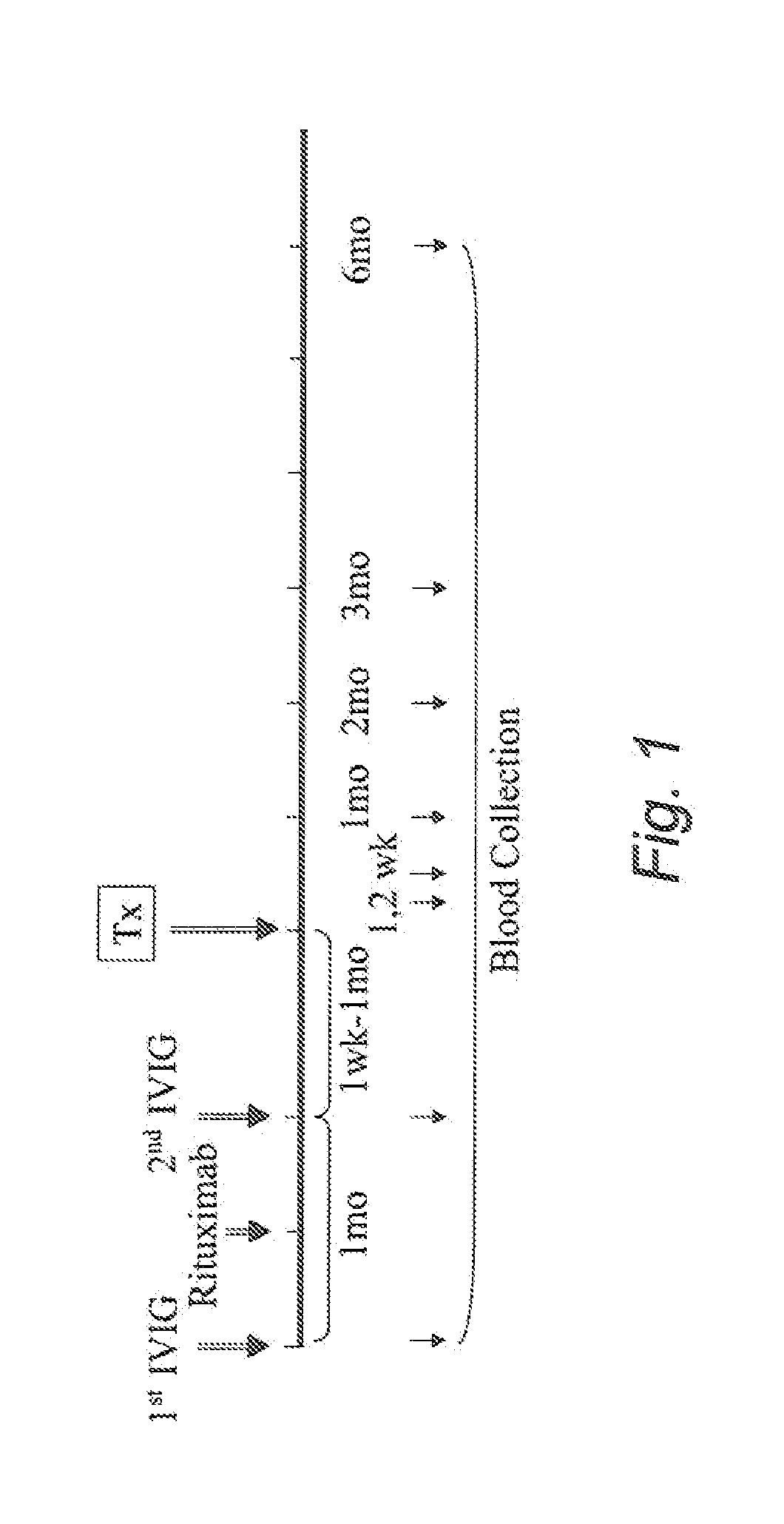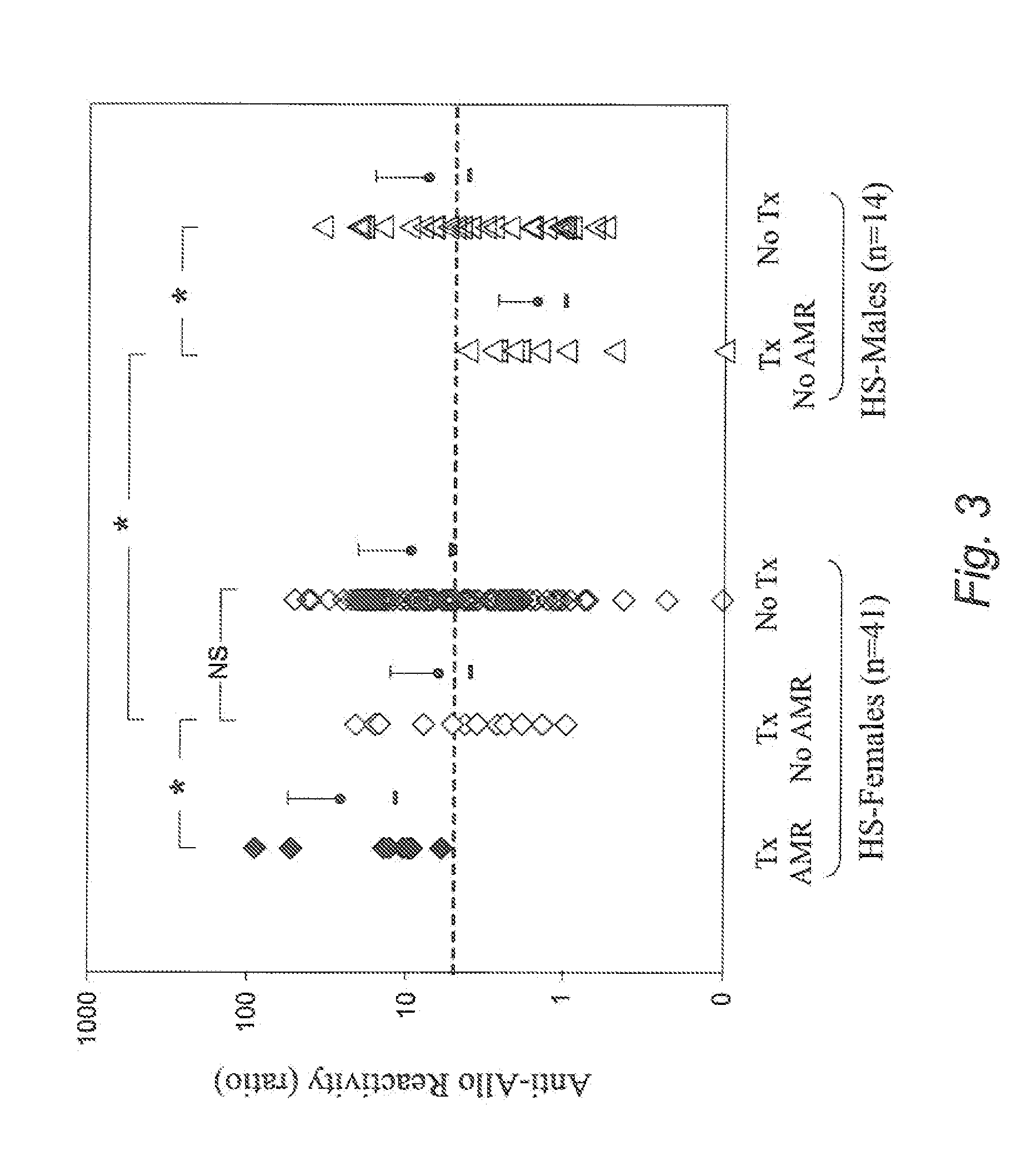Methods of diagnosing and monitoring rejection mediated by antibodies
a technology of antibody mediated rejection and diagnostic method, which is applied in the field of monitoring and predicting antibody mediated rejection, can solve the problems of patients still developing rejection, immediate or delayed loss of a transplanted organ, and significant risk of the transplanted organ, and achieve the effect of detecting susceptibility to the condition, reducing the risk of developing the condition, and reducing the risk of the condition
- Summary
- Abstract
- Description
- Claims
- Application Information
AI Technical Summary
Benefits of technology
Problems solved by technology
Method used
Image
Examples
example 1
General Methods
[0080]50 HS patients undergoing desensitization and receiving a kidney allograft are included. Measurements are taken of the following: i) IFNγ+ cell % in NK cells and other cell populations reactive with allo-PBMCs obtained from donor and 3rd party normal individuals (3rdN), and with allo-ECs obtained from 3rdN by CFC in blood obtained pre- and post-DES, with frequent monitoring post-Tx, and ii) FcγRIIIa genotype by TaqMan SNP genotyping assay using DNA extracted from blood obtained pre-Tx. The follow-up period is 6 months post-treatment for all and 1 year for ⅔ of patients. The total duration is 2 years, with results compared with other clinical data.
example 2
Methods—Patient Population
[0081]HS adult and pediatric patients who receive the DES protocol followed by a kidney allograft from a living ABO compatible or incompatible donor are included. Only living donor Tx are included since the time between DES and Tx fixed at approximately 1 month post-DES, while that in deceased-donor Tx is uncertain. At least 160 kidney Txs per year are performed (240 / 1.5 years). Of these, 40% are highly sensitized or scheduled to receive a kidney (100 patients / 1.5 years). Of these, 50% receive a living-donor Tx (50 patients / 1.5 years).
[0082]The DES protocol consists of 2 doses of IVIG (2 g / kg) one month apart with 1 dose of rituximab (1 g / dose) in between. The IVIG product used in this study is Gamunex-10% (Talecris Biotherapeutics). The flow chart of this study is shown in FIG. 1 herein.
[0083]Flow-CMX against donor is tested pre- and post-DES. When a negative or acceptable CMX (negative CDC-CMX and flow-CMX nd IVIG dose. Using this DES protocol and criteri...
example 3
Methods—Sample Collection
[0086]15 ml of heparinized-blood are obtained from patients and submitted for allo-CFC-PBMC and allo-CFC-EC on the day of blood draw. Blood samples are obtained from each patient at 8 time points (pre-1st IVIG, pre-2nd IVIG, 1 and 2 weeks, 1, 2, 3 and 6 months post-Tx) (FIG. 1). 5 ml of EDTA-anti-coagulated-blood are obtained once from each patient and submitted for DNA extraction followed by FcγRIIIa genotype analysis.
[0087]Heparinised-whole blood is submitted for both allo-CFCs and the remaining blood is centrifuged to obtain plasma for anti-HLA antibody ELISA analysis. Leukocyte pellets are first prepared from the EDTA-anti-coagulated-blood by lysing red blood cells with ammonium carbonate / chloride as previously described and stored at −80° C. for batched DNA extraction and TaqMan SNP genotyping analysis.
PUM
| Property | Measurement | Unit |
|---|---|---|
| Reactivity | aaaaa | aaaaa |
Abstract
Description
Claims
Application Information
 Login to View More
Login to View More - R&D
- Intellectual Property
- Life Sciences
- Materials
- Tech Scout
- Unparalleled Data Quality
- Higher Quality Content
- 60% Fewer Hallucinations
Browse by: Latest US Patents, China's latest patents, Technical Efficacy Thesaurus, Application Domain, Technology Topic, Popular Technical Reports.
© 2025 PatSnap. All rights reserved.Legal|Privacy policy|Modern Slavery Act Transparency Statement|Sitemap|About US| Contact US: help@patsnap.com



